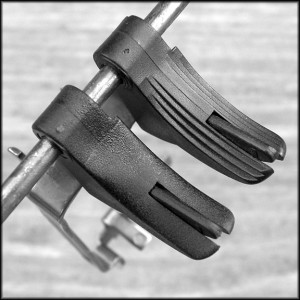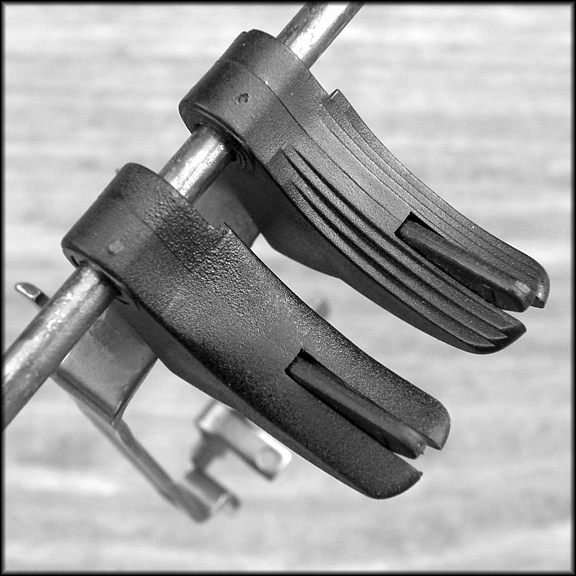In the previous few weeks we’ve talked quite a bit about customizing the Glock pistol with everything from off-the-shelf add-ons to full house custom work from professionals like the good folks at Boresight Solutions…but we haven’t yet discussed one of the most common areas for modification: The trigger. I’ll get around to talking about Glock trigger modifications in a minute, but first I think we need to get some things straight about the weapon we’re dealing with.
The Glock pistol as it comes from the box has roughly a 5.5 pound trigger (slightly heavier in most Gen4 pistols) no manual safety, and it requires a trigger pull to take apart. This arrangement has implications that need to be properly understood before one goes about modifying the characteristics of the trigger. A weapon with a 5.5 pound trigger and no manual safety leaves a razor thin margin of error in terms of handling the weapon. By that I mean if you are not absolutely dialed in at all times with proper handling practices, the odds that you will get an unexpected loud noise are extremely high.
I know what you’re thinking…
…but believe it or not there’s more to this than “booger hook off bang switch!” (By the way, the real “Hoot” was carrying a loaded weapon, but not one that was off safe. Carrying a rifle without the safety on is just daft and it’s not acceptable even in elite units. They tend to be real sticklers about using the safety on an AR) If everyone who handled a gun was doing so with complete attention to what they were doing at all times and never got anything wrong, then there wouldn’t be a problem. Unfortunately, angels don’t handle handguns. People do. People are capable of making mistakes. To wit:
Mr. Grebner probably had no idea he was getting his finger on the trigger early and applying pressure. He’s not alone. I can’t tell you how many times I’ve seen people under the mild stress of an audience and a timer get their finger on the trigger while the pistol they are drawing was still pointed at their anatomy or leaving their finger on the trigger while reholstering. Had Mr. Grebner been using a weapon with a longer, heavier trigger for the first shot, it’s highly likely he would have had enough tactile feedback to realize he was doing something wrong before the loud noise announced it. Under stress or even just when trying to go “fast” it’s entirely possible for you to work your finger inside the trigger and actually apply pressure to the trigger without realizing it…and that leads to tragedy. I’m not going to get into a full rant about the idiocy of the accidental vs. negligent discharge debate now because time doesn’t allow. I’ll simply state that if you’re human enough to stub your toe, miss a turn, or lock your keys in your car, then you’re human enough to launch a round unintentionally…so don’t tempt fate by going for the lightest trigger humanly possible.
When considering trigger modifications it’s also important to understand exactly how the weapon you are working on functions and how to check for proper function of the safety features. Sometimes when installing custom parts that are “drop in” you find out that while they may indeed drop right in, the gun doesn’t work right. While a Glock is a Glock, all Glocks do not have identical dimensions or parts. It’s possible for someone who puts out a custom part to manufacture one that works perfectly well in most Glocks but that in others will do something like disable the function of the striker block. Before you even consider making any trigger modifications to your Glock, you need to be knowledgeable enough about the pistol’s function to perform the factory’s recommended function checks on the weapon. If you aren’t, either educate yourself or just skip trigger mods altogether.
…so with all of that being said, what trigger mods do I favor?

I have a personal disdain for the ridged trigger that Glock insists on using in the compact pistols like the Glock 19 or 26. I greatly prefer the smooth trigger available on the full sized Glocks like the G17. Luckily the smooth trigger from the full-sized guns is cheap and readily available. Beyond that I don’t really mess with the trigger on my Glock pistols. I’ve certainly tried any number of modifications in the past including different connectors and trigger springs, but personally I never found them to be of significant benefit to my shooting. Others have found modifications to be of great benefit to their shooting. The two main changes you can make to a Glock are replacing the connector, or replacing the trigger spring.
Connectors:
There are a number of different factory and aftermarket connectors you can install in a Glock that will change the weight of the trigger pull slightly. Glock makes a 4.5# connector, the standard 5# connector, an 8# connector, a “dot” connector, and a “3.5#” connector…all of which change the weight of the trigger pull to some extent. Please note that the pound rating for the connector doesn’t always mean that’s the trigger weight you’ll get when you actually install the part as the trigger spring also plays a role in the weight of the trigger pull. You can also buy non-Glock connectors from manufacturers like Ghost. Some like to only use the factory connectors, and some have run the Ghost connectors for many rounds with no complaints.
Springs:
The other half of the Glock trigger’s feel is the trigger spring. The stock spring looks like a regular coiled spring one would expect to find in a handgun. Glock also manufactures a couple of other trigger springs that were brought into being at the request of the NYPD when they were in the process of adopting the Glock as their standard issue sidearm. You can get a NY spring or an NY +/NY 2 spring, distinctive because they look like a plastic V with a spring attached in the opening. They are different colors to make the weight of the spring easily recognizable. The key advantage to most who use these springs is providing more of a rolling break (think closer to a DA revolver’s trigger characteristics) than the stock setup. They can be used primarily to increase the weight of the trigger pull, but I don’t know any individual who does that. It’s primarily a practice among agencies who want to increase the margin of error on the weapons in hopes of avoiding liability. Yes, police departments and government agencies have been sued for issuing Glocks when somebody gets an unexpected loud noise and a gunshot wound.
Frequently the springs and connectors are mixed and matched. One of the most popular modifications is to pair a NY trigger spring with a 3.5# connector to produce a roughly 6 pound trigger with a nice rolling break. With the addition of the Gen4 line of pistols Glock changed the geometry of some of the internal parts on the entire lineup of Glocks so that now they tend to come with slightly heavier triggers out of the box than they used to. When you combine the possibilities of Gen4 spec parts vs. Gen3 spec parts, half a dozen different flavors of connector, and a bunch of trigger spring options it gets rather difficult to predict exactly what you’ll get when you buy a particular part and install it in your gun. Hence my words of warning earlier. Firearms manufacturers are always making changes to the weapons they produce that don’t get publicized. Even factory trained armorers may not know about all the changes, and so it’s crucial that if you’re going to futz with the fire control components of your handgun that you’re able to verify that the weapon is in safe and functional order before you attempt to carry or use it.
Again, I’ve tried lots of different combinations with Glock triggers but after a while I generally end up ditching the parts I installed and going back to the stock configuration. Some of my best shooting buddies swear by various trigger modifications. In an online conversation one of them mentioned that in his Gen4 Glock he likes to install a Gen3 G17 trigger bar, a factory “-” connector (AKA 3.5# connector), and even a Wolff 5# striker spring. He’s also one of the most analytical human beings I know, keeping spreadsheets of his performance in various endeavors to track progress. I’m more of a Cro-Magnon when it comes to this stuff. “Ogg pull trigger. Ogg hit target. Ogg anticipate, Ogg no hit target. Unga-bunga.” He’s the sort of guy who encounters a locked door and picks the lock. I’m the sort of guy who smashes it in with a battering ram.
If you want to modify the trigger of your Glock, you have lots of options…but please understand exactly what it is you’re doing to the weapon if you decide to modify it. Learn to perform an armorer-level check of the weapon’s function and whatever you do, don’t get stupid with the trigger weight. There are people out there right now carrying Glocks with 2 pound triggers in appendix holsters and it’s only a matter of time until one of them kills themselves.
Please…please…be very careful about modifying the trigger on your Glock. There’s nothing wrong with modifying your pistol, but do so intelligently…with the full understanding of what it is you’re doing and the risks/rewards that go along with it.
Stay safe…
